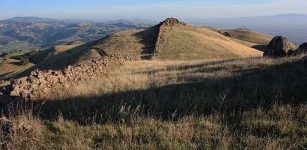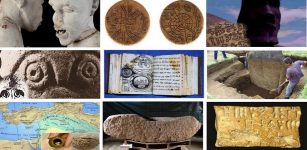Mystery Of Viking Ruler Rollo Continues – Surprising Discovery In Ancient Grave
Conny Waters - AncientPages.com - The mystery of Viking ruler Rollo continues. An ancient sarcophagus Fécamp, Normandy, France has been opened, and analysis has been conducted, but the results are startling and not what anyone expected.
While trying to solve an ancient mystery, a new one has suddenly emerged.
Researchers Andaine Seguin Orlando and Per Holck examine the bones in the sarcophagus. Image credit: Samlerhuset
There are many famous Vikings whose identity is unknown and one of them is Viking Rollo who was the founder and first ruler of Normandy, the Count of Rouen, and the great-great-great grandfather of William the Conqueror, the first Norman King of England. The identity of Viking ruler Rollo is of great historical significance. For years, there has been debated whether Viking Rollo was from Denmark or Norway. The answer is important to the British royal family because their family descended from Rollo.
As MessageToEagle.com previously reported, last year, scientists opened a sarcophagus that might shed new light on Viking Rollo’s identity.
In January 2016, French officials granted a Norwegian application to open the tomb of Rollo’s grandson and great-grandson, Richard I of Normandy (also known as Richard the Fearless) and Richard II, also called Richard the Good.
Who Was Viking Rollo?
Very little is also known about Viking Rollo. He was born in the latter half of the 9th century somewhere in Scandinavia and came from a noble warrior family.
In 876 he led the Viking fleet which besieged Paris and attacked Bayeux and Évreux between 885 and 887. Some historians maintain Rollo became an experienced Viking, visiting Scotland and probably Ireland before he came to France.
Being a very tall man who preferred to walk instead of riding a horse, Rollo was often called Rolf the Walker. He was also noted for his strength and martial prowess.
Viking Rollo was such a big burden for the king Charles the Simple, that he offered Rollo the northeastern part of his kingdom just to avoid looting.
Statue of Viking Rollo in Ålesund, Norway. Image credit: Nils Harald Ånstad
In the reign of Charles II the Bald, Rollo sailed up the Seine River and took Rouen, which he kept as a base of operations. He gained a number of victories over the Franks and extorted the cession of the province since called Normandy.
Through the famous treaty which Charles the Bald and Rollo signed the latter agreed to adopt Christianity.
Viking Rollo died in 932 and was buried in the Cathedral at Rouen, but we still do not know where he came from.
While Norwegian-Icelandic history holds that Rollo is the same man also known as Ganger Hrólf and hails from Norway, some Danish historians claim that Rollo is from Denmark.
Shocking Discovery – The Skeletons Are Much Older
Forensic experts from the Centre for GeoGenetics in Copenhagen, Denmark, and the University of Oslo, Norway have now examined the two corpses in the burial and released the results.
The results are disappointing, not only for the Danes but also for the Norwegians. The two skeletons in the sarcophagus are in no way related to Viking Rollo. They are much older!
“These skeletons have nothing to do with Rollo. The skeletons in the sarcophagus are in fact much older, one from 250-300 years before our era and the other from around the year 700, that is, before the Viking era, “ says historian and project initiator Sturla Ellingvåg from Foundation explico.
The condition of the skeletons was unfortunately very poor, and researchers were unable to obtain DNA.
What is really interesting is that the elder skeleton is actually from the 3rd Century BC!
“This has caused quite a stir, and since the elder is from 1-2 centuries before the Roman conquest of the area, we are speculating if this could be the relic of an early Celtic chieftain. At the moment, we have sent in a tooth for Strontium Isotop analysis, and we expect to know more about this issue soon,” Ellingvåg says.
Why Was A Celtic Chief Buried In A Duke Coffin?
According to researchers, the Celtic chief was probably moved from another grave, which was not uncommon at the time.
Scientists open the sarcophagus in the abbey Fécamp, Normandy. Image credit: Vegard/Strömsodd/Explico
To avoid plundering and destruction, many churches and graveyards were moved during the Viking raids in Northern Europe. Later, churches were rebuilt.
Why these people were placed in Duke's coffins is unknown because there are no proper historical writings that could shed light on the mystery.
Is There Another Way To Determine Viking Rollo’s Identity?
The hope is still not gone and it might be possible to learn more about Viking Rollo’s identity. One way is to examine the DNA of people living in the area, but it’s difficult to conclude anything from these tests, Ellingvåg points out.
British and French scientists tried it in 2016.
The results of Viking DNA project show that 89 men in Normandy have surnames that could indicate that they are of Nordic origin. However, the results showed no direct genetic line of these men to Scandinavia.
Researchers are now hoping they can get permission to open another grave in Normandy and conduct a DNA test, but for the moment they are unwilling to reveal which one.
The mystery of Viking Rollo remains unsolved. Danes and Norwegians have argued about Viking Rollo’s identity for over 100 years and they must wait a little longer before this historical mystery will be solved.
Written by - Conny Waters - AncientPages.com
Expand for references






















